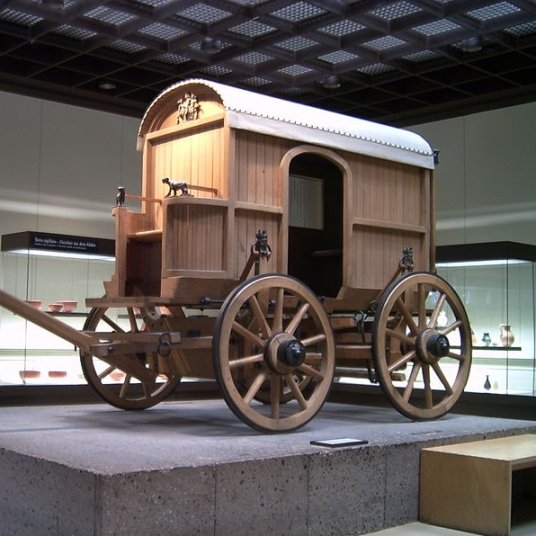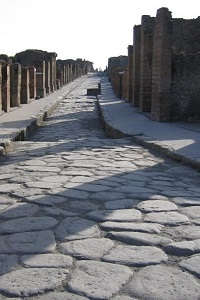Roman Carriages and Transportation: How the Ancients Travelled
Updated on: 08 June 2025Reading time: 4 minutes
Ancient Romans used carriages and other forms of transportation, the most basic one being walking! In fact, walking was the most common way of getting around, while carriages were primarily used for transporting goods or travelling long distances.
Roman carriages had iron-shod wheels (rubber did not exist at the time), which meant they made a considerable amount of noise. Carriages were prohibited in large cities such as Rome during the day, so residents had to endure the sound of their wheels during the night.
Everyday Roman Carriages
The plaustrum was one of the most common vehicles in Rome. It was mainly used to transport construction materials or agricultural goods such as cereals, olive oil, and wine. It was the equivalent of today’s lorries. It consisted of a wooden platform with two to four thick, solid iron-shod wheels. It generally had no top and no sides and was typically drawn by two oxen, which were very powerful.
The essedum was a small, two-wheeled chariot with no roof and a closed front, accommodating two standing passengers. It was pulled by one or several horses or mules and was rather swift. The cisium was not as fast. It also had two wheels and no roof, with a seat for two passengers, and was drawn by one or two mules or horses. It was either driven by a driver – similar to a modern taxi driver – or by the passenger himself.
The raeda was the equivalent of our buses. It had four wheels, multiple benches, and space for luggage. By Roman law, luggage weight could not exceed 1,000 Roman libra (approximately 330 kilograms). It either had no roof or a cloth covering and was drawn by many oxen, mules, or horses – sometimes up to four horses and even more mules!
Surprisingly, Romans did not generally use horses for personal travel. They lacked much of the equipment we have today, such as stirrups, which provide a stable and comfortable ride.
Transportation of the Wealthy
Wealthy Romans – particularly women – would often use a litter (either privately owned or rented) for travel within the city or on very short trips. Six slaves (bearers) would carry one or two reclining individuals in the litter. Wealthy women frequently used litters to avoid contact with the working classes. City streets were not always safe, especially for attractive wealthy women.
The carpentum was the bus or limousine of affluent Romans. It had four wheels, a wooden arched roof, and was comfortable, spacious, and often ornately decorated. The carruca was a smaller version of the carpentum, typically used by the wealthy and capable of accommodating two passengers. Both the carpentum and carruca featured a form of suspension using metal and leather straps to make the ride more comfortable.

(Public Domain CC-BY-SA-3.0) |
Travel Time in Ancient Rome
Travel during Roman times was slow and exhausting. According to ORBIS – the “Google Maps” of the ancient world, developed by Stanford University – it took six days to travel from Rome to Naples, compared to about 2 hours and 20 minutes today (source: Google Maps). As carriages often lacked suspension, journeys on paved Roman roads were uncomfortable and tiring. Due to their iron-shod wheels, Roman carriages were also very noisy and could be heard throughout the night, as they were banned from city centres and their surroundings during the day.
Romans would rest at way stations called mansiones – meaning “staying places” in Latin – the equivalent of modern-day motorway service areas. These mansiones were built at regular intervals (approximately 15 miles or 25 to 30 km apart) along Roman roads and featured restaurants and inns where travellers (and their animals) could eat, drink, and sleep. They were sometimes unsafe, being frequented by prostitutes and thieves preying on travellers.
The fastest mode of travel in ancient Rome was via a horse relay service known as the cursus publicus. This state-run postal system – comparable to the Pony Express in 19th-century America – was used to transport government correspondence and officials (e.g. military commanders, magistrates, etc.). To access this service, officials required a permit issued by the emperor. The cursus publicus was made up of a network of stations placed at short regular intervals (approximately 8 miles or 12 km apart), each stocked with fresh, swift horses.
Historians differ in their estimates of the speed of the cursus publicus. In a study entitled “The Speed of the Roman Imperial Post” by A.M. Ramsey (Journal of Roman Studies), a typical day’s travel ranged between 41 and 64 miles (66–103 km). Thus, a journey from Rome to Naples via the cursus publicus took approximately two days.
Various Modes of Land Transportation in Ancient Rome
| Transportation type | ||||
| Pedestrian | 12 - 16 | Human legs. | Many | |
| Litter | 1-3 | Carried by six slaves, typically within city limits | Short-distance travel | |
| Horse | 30-35 | Horseback | Personal travel | |
| Plaustrum | 10 - 15 | Wooden platform, no roof, 2–4 thick wheels, drawn by oxen | Heavy goods transport | |
| Essedum | 25-30 | Small open-top chariot with closed front, two standing passengers | Personal (and some goods) transport | |
| Cisium | 25-30 | Open-top, two seats, drawn by horses or mules | Personal transport | |
| Raeda | 20-25 | Cloth or open roof, many benches, drawn by teams. | Passenger transport | |
| Carpentum | 20-25 | Arched wooden roof, comfortable | Wealthy passenger transport | |
| Carruca | 20-25 | Smaller carpentum, seats two | Wealthy passenger transport | |
| Cursus clabularis | 20-25 | Cloth roof, drawn by teams | Military equipment transport |
Interesting Facts About Roman Carriages
|
SOURCES
